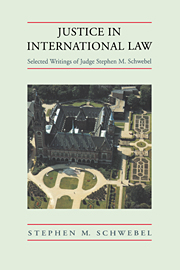Book contents
- Frontmatter
- Contents
- Preface
- PART I International Court of Justice
- 1 Reflections on the Role of the International Court of Justice
- 2 Relations Between the International Court of Justice and the United Nations
- 3 Was the Capacity to Request an Advisory Opinion Wider in the Permanent Court of International Justice than it is in the International Court of Justice?
- 4 Authorizing the Secretary-General of the United Nations to Request Advisory Opinions of the International Court of Justice
- 5 Preliminary Rulings by the International Court of Justice at the Instance of National Courts
- 6 Chambers of the International Court of Justice Formed for Particular Cases
- 7 Three Cases of Fact-Finding by the International Court of Justice
- 8 Indirect Aggression in the International Court
- 9 Human Rights in the World Court
- PART II International Arbitration
- PART III United Nations
- PART IV International Contracts and Expropriation
- PART V Aggression under, Compliance with, and Development of International Law
- List of publications
- Index
8 - Indirect Aggression in the International Court
Published online by Cambridge University Press: 06 November 2009
- Frontmatter
- Contents
- Preface
- PART I International Court of Justice
- 1 Reflections on the Role of the International Court of Justice
- 2 Relations Between the International Court of Justice and the United Nations
- 3 Was the Capacity to Request an Advisory Opinion Wider in the Permanent Court of International Justice than it is in the International Court of Justice?
- 4 Authorizing the Secretary-General of the United Nations to Request Advisory Opinions of the International Court of Justice
- 5 Preliminary Rulings by the International Court of Justice at the Instance of National Courts
- 6 Chambers of the International Court of Justice Formed for Particular Cases
- 7 Three Cases of Fact-Finding by the International Court of Justice
- 8 Indirect Aggression in the International Court
- 9 Human Rights in the World Court
- PART II International Arbitration
- PART III United Nations
- PART IV International Contracts and Expropriation
- PART V Aggression under, Compliance with, and Development of International Law
- List of publications
- Index
Summary
We are living through dramatic days of the direct use of force by one State against another across an internationally recognized frontier. Today's issue is not one of indirect aggression but of direct conquest. Apart from the failed but bloody and destructive attempt to conquer the Republic of Korea in the early 1950s, this use of force is largely without parallel in the 45 years in which the United Nations Charter has been in force. As has been widely appreciated, current events rather evoke events of the 1930s.
Equally unparalleled is the unity and trenchancy of the resultant resolutions of the Security Council. Those resolutions are replete with invocations of international law and the authority of the Security Council to bind States – to bind both the object of the sanctions and the States enjoined to apply sanctions. Current concerns thus focus on a direct use of force which the Security Council has authoritatively condemned and is seeking vigorously to deal with by applying the panoply of powers accorded it by the terms of the Charter.
I cannot speculate on whether the International Court of Justice may play a part in these portentous proceedings, nor can I address events bearing on cases pending before the Court; I am obliged to confine my remarks to the substance of what I have earlier expressed in Court opinions. Within those confines, I do wish to make some observations on what part the Court can play in dealing with the legal aspects of the use of force in international relations, and what role it has played.
- Type
- Chapter
- Information
- Justice in International LawSelected Writings, pp. 140 - 145Publisher: Cambridge University PressPrint publication year: 1994



